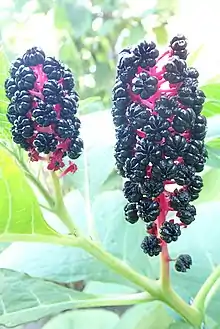| Phytolacca acinosa | |
|---|---|
 | |
| Scientific classification | |
| Kingdom: | Plantae |
| Clade: | Tracheophytes |
| Clade: | Angiosperms |
| Clade: | Eudicots |
| Order: | Caryophyllales |
| Family: | Phytolaccaceae |
| Genus: | Phytolacca |
| Species: | P. acinosa |
| Binomial name | |
| Phytolacca acinosa Roxb. | |
| Synonyms[1] | |
| |
Phytolacca acinosa, the Indian pokeweed, is a species of flowering plant in the family Phytolaccaceae.[2] It is native to temperate eastern Asia; the Himalayas, most of China, Vietnam to Japan, and has been widely introduced to Europe.[1] The species was originally described by William Roxburgh in 1814.[3][2]
Range
When the species was originally described it was considered a plant located to Nepal.[3] Currently, the plant is considered native to countries surrounding the Himalayas and introduced to large parts of Europe and parts of the United States (Wisconsin).[1]
Ecology
Indian pokeweed is a hyperaccumulator for manganese.[4][5]
Uses
As a wild food
The young shoots of Indian pokeweed are cooked and eaten by the Gurung people of western Nepal.[6] They are harvested in June and July.
Similar species (look-a-likes)
Due to overlap in diagnostic feature Phytolacca acinosa can be confused with Phytolacca americana, Phytolacca latbenia or Phytolacca polyandra.[7]
 P. americana
P. americana P. polyandra
P. polyandra
Natural products
Phytolacca acinosa is the source of four flavones,[8] four, oleanane derivatives,[9] and six triterpenoid saponins.[10]
Flavones
- Cochliophilin A
- Cochliophilin B
- 6-methoxy-7-hydroxy flavone
- 6,7-methylenedioxy-4-hydroxypeltogynan-7′-one
Triterpenoid saponins
- esculentoside A
- esculentoside B
- esculentoside C
- esculentoside D
- esculentoside H
- esculentoside T
References
- 1 2 3 "Phytolacca acinosa Roxb". Plants of the World Online. Board of Trustees of the Royal Botanic Gardens, Kew. Retrieved 15 June 2021.
- 1 2 "Phytolacca acinosa Roxb". www.gbif.org. Retrieved 2021-06-11.
- 1 2 Carey, William, 1761-1834; Roxburgh, William, 1751-1815; Calcutta Royal Botanic Garden (1814), Hortus Bengalensis, or a Catalogue of the Plants Growing in the Hounourable East India Company's Botanical Garden at Calcutta (PDF), Wikidata Q16575978
{{citation}}: CS1 maint: multiple names: authors list (link) CS1 maint: numeric names: authors list (link) - ↑ Xue, S. G.; Chen, Y. X.; Reeves, Roger D.; Baker, Alan J. M.; Lin, Q.; Fernando, Denise R. (2004-10-01). "Manganese uptake and accumulation by the hyperaccumulator plant Phytolacca acinosa Roxb. (Phytolaccaceae)". Environmental Pollution. 131 (3): 393–399. doi:10.1016/J.ENVPOL.2004.03.011. PMID 15261402.
- ↑ Xu, Xianghua; Shi, Jiyan; Chen, Yingxu; Chen, Xincai; Wang, Hui; Perera, Anton (2006-06-27). "Distribution and mobility of manganese in the hyperaccumulator plant Phytolacca acinosa Roxb. (Phytolaccaceae)". Plant and Soil. 285 (1–2): 323–331. doi:10.1007/S11104-006-9018-2.
- ↑ Khakurel, Dhruba; Uprety, Yadav; Łuczaj, Łukasz; Rajbhandary, Sangeeta (2021-10-21). "Foods from the wild: Local knowledge, use pattern and distribution in Western Nepal". PLOS ONE. 16 (10): e0258905. doi:10.1371/journal.pone.0258905. ISSN 1932-6203. PMC 8530312. PMID 34673823.
- ↑ "Phytolacca acinosa | Manual of the Alien Plants of Belgium". alienplantsbelgium.be. Retrieved 2021-07-24.
- ↑ Xiao-Pan Ma; Wen-Fang Zhang; Ping Yi; Jun-Jie Lan; Bin Xia; Sai Jiang; Hua-Yong Lou; Wei-Dong Pan (30 September 2017). "Novel Flavones from the Root of Phytolacca acinosa Roxb". Chemistry and Biodiversity. 14 (12). doi:10.1002/CBDV.201700361. ISSN 1612-1872. PMID 28963759. Wikidata Q47894904.
- ↑ T.K. Razdan; S. Harkar; V. Kachroo; G.L. Koul; E.S. Waight (25 July 2002). "Triterpenoids from Phytolacca acinosa, three oleanane derivatives". Phytochemistry. 22 (8): 1797–1800. doi:10.1016/S0031-9422(00)80274-5. ISSN 0031-9422. Wikidata Q104950731.
- ↑ Jiao He; Jie Ma; Dao-Wan Lai; Yong-min Zhang; Wen-Ji Sun (9 August 2011). "A new triterpenoid saponin from the roots of Phytolacca acinosa". Natural Product Research. 25 (18): 1771–1775. doi:10.1080/14786419.2010.535155. ISSN 1478-6419. PMID 21827284. Wikidata Q45204476.